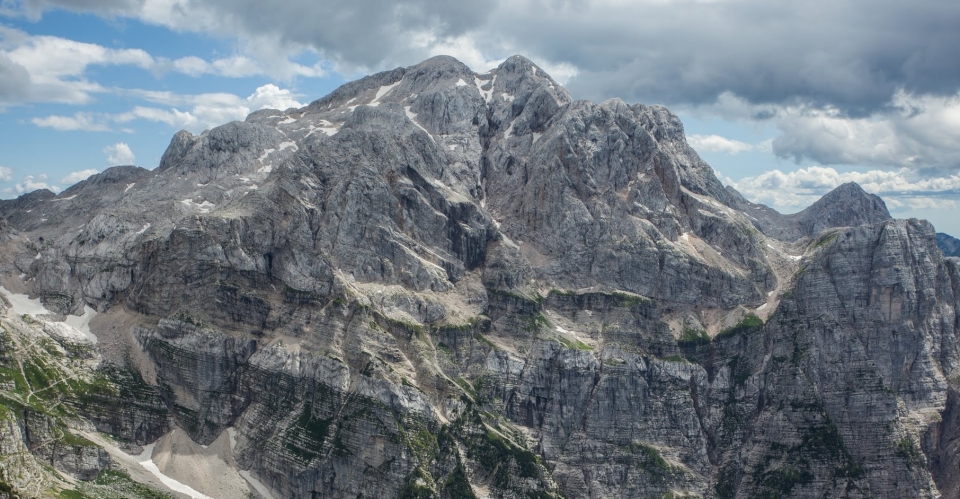Krn
2244 m.a.s.l.Krn, with an elevation of 2244 m, is the highest peak of the Krn mountain range.
At the top, there is an observation point. The view is beautiful, stretching from the Adriatic Sea through Matajur and Breginjski or Kobariški Stol to Kanin. To the north and east, the highest peaks of the Julian Alps can be seen. In good weather, the view can extend much further.


Špik
2472 m.a.s.l.Špik is a majestic mountain with an impressive northern face, which, due to its shape, is one of the most admired peaks in the Julian Alps.
It is located in the heart of the Martuljek mountain group. From the top, there is a beautiful view of the Karawanks, the Upper Sava Valley, the Martuljek group, and other highest peaks of the Julian Alps. The mountain got its name due to its pointed shape.
Prisojnik
2547 m.a.s.l.Prisojnik, also known as Prisank, is a 2547 m high mountain located above the valleys of Mlinarica, Krnica, and Suha Pišnica.
The mountain is fragmented into numerous ridges and peaks, which enclose deep ravines and cirques. In the western part of the mountain, there is the Prednje (veliko) okno (Front- Big- Window), while the Zadnje (malo) okno (Back- small- window) is on the western side. Both are considered natural landmarks. A well-known feature of Prisank is the "Ajdovska deklica", which is clearly visible from the Vršič road. From the top, we can enjoy a beautiful view of the highest peaks of the Julian Alps.


Kanjavec
2569 m.a.s.l.Kanjavec is a 2569 m high mountain located between Dolič and Hribarice. From the top, we can enjoy a beautiful view of Triglav and other mountains above the valleys of Trenta and Bohinj.
Razor
2601 m.a.s.l.
The top is located above the Alpine valley of Mlinarica. There isn't much space at the top, but the view from there is beautiful. All the peaks above the Kriški Podi are clearly visible, including Triglav and Jalovec.


Jalovec
2645 m.a.s.l.Jalovec has an elevation of 2,645 meters and is the fourth highest mountain in the Julian Alps.
From the top, three Alpine valleys are clearly visible: to the northeast, Tamar with Planica; to the west, Loška Koritnica; and to the southeast, Zadnja Trenta. A beautiful view opens up of the highest peaks of the Julian Alps.
Mangart
2679 m.a.s.l.Mangart, also known as Mangrt, is the third highest mountain in the Slovenian Julian Alps and is very popular in the summer.
Access to the top is significantly shortened by a road that ascends to over 2,000 meters. On the top, there is a cross and a register box underneath it. The top is spacious and offers a beautiful view in all directions. The neighboring Jalovec, which is just a few meters lower, is particularly well visible. The Italian Julian Alps are also clearly visible.


Škrlatica
2738 m.a.s.l.Škrlatica is the highest peak of the large mountain massif between Vrata and Velika Pišnica, and with its height of 2,738 meters, it is the second highest peak of the Eastern Julian Alps.
Škrlatica is named after its scarlet-colored northwest wall, which glows red during sunset. At the top, there is a cross, making it easy to identify the peak from neighboring mountains. From the top, there is a very beautiful view of all the peaks above the Vrata Valley, especially of Triglav and the nearby Dolkova Špica.
Triglav
2864 m.a.s.l.At 2,864 meters, Triglav is the highest mountain in Slovenia and also the highest peak in the Julian Alps.
The first ascent of Triglav was made on August 25, 1778, by four men from Bohinj: Luka Korošec, Matija Kos, Štefan Rožič, and Lovrenc Willomitzer. At the summit stands the famous Aljaž tower, which was built in 1895 by Jakob Aljaž, the mayor of Dovje. The Aljaž tower is a protected cultural monument. From the top of the Triglav, there is a stunning view, which, in good weather, stretches all the way from the Adriatic Sea, the Dolomites, and the High Tatras to the Karavanke, the Kamnik–Savinja Alps, Pohorje, and nearly all of Slovenia, up to the highest peaks of the Julian Alps.

Thank you.

